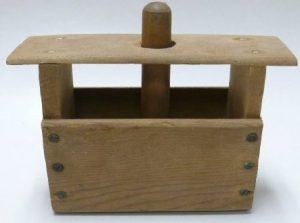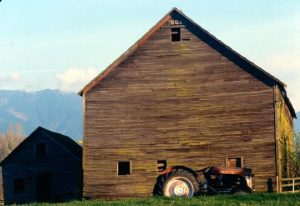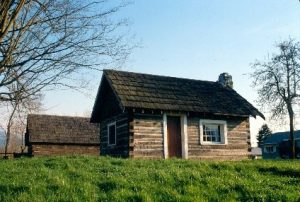Connections – Why I Support the Chilliwack Museum and Archives by Vivian Evans Walker

Butter Mold 1981.028.012ab
When I was a child, if I wanted to know something about “the olden days” I would often ask Gramma. What was it like to travel in a covered wagon from the Dakotas to Alberta? Were you dizzy the first time you took a train? How can I make butter from scratch? Gramma knew. She was a living connection to questions about the past.
If I wanted to know about being a wartime kid in Vancouver, I would ask Mom. Her father was a world champion ski jumper, but like many families in the 1930s, they lived in poverty. She saw the huge migration of Prairie farm kids to North Vancouver in the early 1940s, when families crammed into “wartime houses,” eager for the work the shipyards brought. She watched four of her brothers go to war. She was a Junior Air Raid Warden, doing her part for the war effort at age 10.
For almost everything else, I asked Dad. He had a coin collection gleaned from the mud under the horse barn, where the farmhands played poker while waiting for mares to foal. He regretted rarely eating the food prepared for the Chinese field hands by the Chinese cook on the farm but could show me the tiny opium bottles found near their bunkhouse. He would read us sections of the Charles Evans Diary, which details my great-great grandfather’s journey from Picton County in Ontario “around the Horn” to Victoria. He would show me the farm ledgers kept by my great-great grandmother, Jane Wells Evans, detailing her struggle as a young widow to turn rich but soggy soil into a productive farm.

Evans Farm Horse Barn – PP502545
These memories lived with us as children. The ledger and diary were on the top shelf of the linen closet. I could literally touch Chilliwack’s history. Inspired by his cousins Casey and Oliver Wells, my dad was an early trustee of the Historical Society and spoke of the days in the future when some of the relics we grew up with would seem quaint to future generations.
Do I have any of these relics? No, and I am actually happy I do not. We have a large family. My gramma and my Aunty Milly (Mildred Evans Hall) made the wise decision to donate many of our family’s special items to the Museum for all to experience. The abacus I played with as a child, the journals, the opium bottles, the beautiful bowl my great-grandmother received as a wedding gift and many other more mundane family treasures all live in the Chilliwack Museum.

Evans Farm Cabin -PP502549
These items, though, are part of the Museum’s collections. For the Museum to truly resonate and move forward, we need to invest in connections. Today’s kids want to be entertained. The stories of the Museum’s collections come alive in a way that makes Chilliwack’s history compelling. We work constantly to use best practices to do this. Last year we expanded our school programs to include the Classroom-in-Residence program. It fully engaged intermediate students in an integrated study of their community, with the Chilliwack Museum and Archives as the launching pad for their explorations. Overwhelmingly, their feedback after the program spoke of how they felt more connected to their community’s history.
How do I help the Museum to create better programming? I support the Museum by volunteering my time as a trustee, just as my dad did. My mom and I created an Adopt-a-School fund so money isn’t a barrier preventing schools in low-income areas from visiting the Museum. And although I am now retired, every month I make a small gift to the Chilliwack Museum so we can offer Chilliwack kids the best in programming. With that support, they, too, can form the connections I did to Chilliwack’s history.
Vivian Evans Walker
If you would like to support the Chilliwack Museum and Archives by donating, please go to our secure online donation page at CanadaHelps.
If you are interested in supporting the Chilliwack Museum and Archives by becoming a Museum member or volunteer, please learn more at our website.

Comments are closed.